|
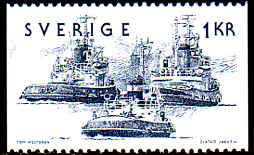
|
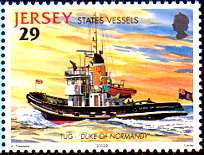
| |
Tugs are differentiated by its targeted application and the resulting design:
High sea tugs for the transportation of high sea lighters, damaged ships and drilling rigs.
They also serve as supply ships for drilling rigs and to shift their anchors.
Rescue tugs to help damaged ships.
Port tugs to support large ships during berthing operations and helping them through narrow passages.
Tugs for inland waterways and rivers; they tow or shove small boats and lighters through channels and rivers.
You can also distinguish tugs by the type of connection: Some have a line connection to the ship and tow it to its
destination. Others have direct contact and shove it forward (push formation).
Looking at the type of propulsion there are steam tugs with and without side wheels,
engine tugs, tugs with a Schottel drive, Z drive, Azimuth-podded drive and with Voith-Schneider propellers.
These are called tractor or rotor tugs.
|
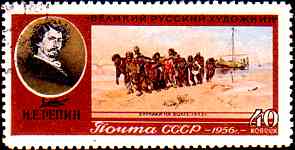
|
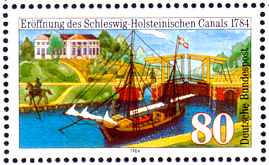
|
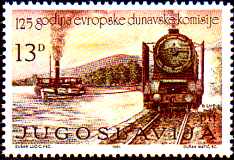
|
In earlier times ships were towed from the embankment on rivers and channels if it was safe to run
a line to the ship. On the left stamp above people "tow" a boat on the river Volga.
On the stamp directly above a rope runs from the ship to a rider ashore. The work was done by horses, e.g. on the
Schleswig-Holstein Canal. On the stamp to the left a train tows a ship in the Siper Canal, connecting the river Danube,
where the current is up to 18 km/h strong.
| |
The Panama Canal also used small trains to tow the ships into the locks.
See the Maritime Topics page about
Panama to this.
|
In 1801 the Englishman William Symington built a tug for Lord Dundas, the 'Charlotte Dundas'.
It was the first engine-driven tug of the world. It replaced the tow horses for the lighters on the
Fourth and Clyde channel.
The boat had a tail wheel, two rudders and a steam-driven engine with 10 hp. During tests it dragged
two 70-tons lighters for 31 kilometers. Local residents and owners of the channel feared for their
jobs and opposed the enterprise.
|
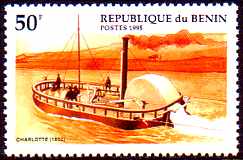
|

| |
In 1820 more steam driven tugs followed. Their task was to tow the huge sailing ships into
the ports and to their berths (see stamp to the right). These first tugs were fitted with paddlewheels.
On the stamp to the left above the first South African tug is depicted - the "Pioneer". She was built 1859
and used up to 1902. On the stamp to the right the steam tug "Sir Charles Elliot" is depicted, built 1902.
On the aft ship the typical linen hangers can be seen. 1942 the tug ran aground during the rescue operation
for the shipwrecked "Dunedin Star".
|
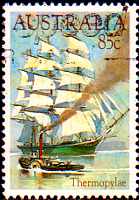
|
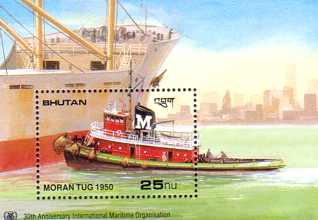
|
Today port tugs have an engine performance from 2,000 to 4,000 kW, depending on type and size.
Towing performance is measured with bollard pull in tons. It ranges from 20 to 60 tons. High sea tugs have
an engine performance from 10,000 to 15,000 kW and a bollard pull from 125 to 250 tons.
| |
On this stamp you can see an American Moran tug which turns a ship by pushing. These shoving tugs
have a particularly reinforced trunk and are surrounded with extra fenders or old rubber tires.
|
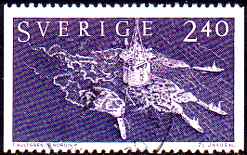
|
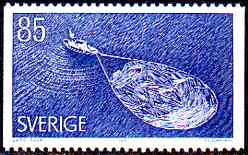
|
In the 19th century the tugs were used to support sailing ships at port and coastal areas.
During thse times they served as pilot boats as well. Towing fishing boats back to port was a thriving business.
On the stamp to the left you can see four tugs towing a drilling rig to a drilling field. To the right
a little tug is pulling a bundle of tree-trunks.
|
|
Rescue tugs are supposed to tow grounded ships into deeper water or if necessary directly to
a shipyard. The master of the damaged ship has to officially issue the order to the tug captain.
The agreement goes "No cure, no pay!". Often tugs of rival shipping companies arrive at the damaged ship
hoping for the order.
|
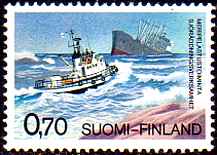
| |
These tugs also have pumps and aqualungs to help leaking ships and they
rescue crews from ships run aground.
|
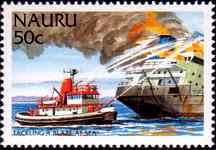
|
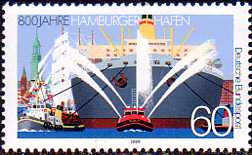
| |
Today nearly all tugs are equppied with fire exstinguish systems. These systems are grouped in
"fire fighting classes" (FiFi) and contain water cannons and extinguisher foam. On special occasions
they are used to create welcome fountains (see stamp to the right).
|
|
Platform tugs drag drilling rigs to their work locations and they are used as supply ships (platform
supply vessel, PSV). The position of a drilling rig has to be changed very often and a lot of anchors
must have to be relocated. These tugs have a big free stern to carry the anchors (as depicted on the
stamp to the right).
|
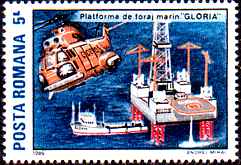
|
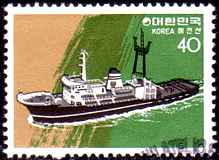
|
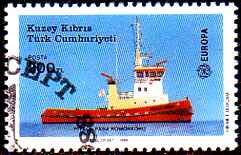
|
The tasks of the high sea tugs include towing big ships and pontoons over long ways on all possible
high sea routes. To the left you can see the high sea tug "Chung Ryong No.3".
In 1977 it was built in Korea, 1,486 BRT, L-233 ft, B-44ft, D-18 ft, 9,600 hp,
two screws, 15.75 kn. The ship was renamed repeatedly.
On the tug to the right you can recognize the all around bridge as it is common today. The
tug captain has a free view to all sides.
|
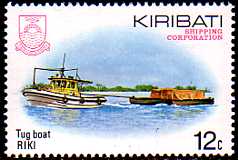
|
The little river tug "Riki" tows as lighter.
Nevertheless the inland waterways were dominated by pusher tugs or push-groups.
|
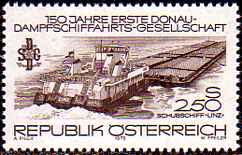
|
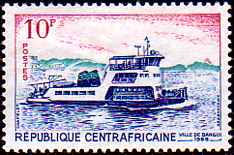
|
On the stamp to the left you can see the push ship "Linz", length 118 ft, beam 34 ft, two diesel engines each 1,100 hp,
built in 1969, two propellers in Kort nozzles, four main rudders behind the propellers to control the 820 ft long
push-group. Every lighter has a length of 238 feet and a beam of 36 feet to take 1,100 tons of cargo.
The push tug "Ville de Bangui" is depicted to the right. It was built in 1958 in Leopoldville, length 91 ft, beam 25 ft, 450
hp. The crew and their families live aboard. The ship runs between Bangui and Brazzaville.
|
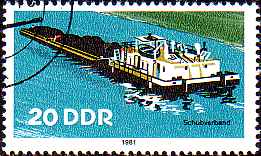
|
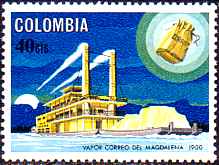
|
To the left a German "KSB 190 Z" pusher tug. 74 units were built of this type. They were 46 ft long,
27 ft wide and had a machine performance of 148 kW.
To the right you can see a mail steamer pushing a lighter on the Magdalena river in Colombia.
|
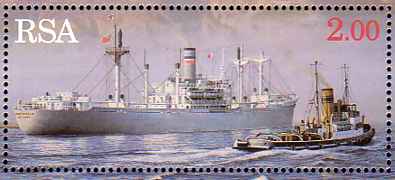
| |
During the 19th and in the begining of the 20th century the tugs were equipped with steam-driven engines.
These were compound engines (multiple expansion machines), an enhancemant of the
single-cylinder steam engine. The temperature and pressure grade is distributed between several cylinders
to get the maximum possible thrust. Triple expansion machines could reach up to 750 hpi.
|
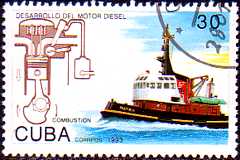
|
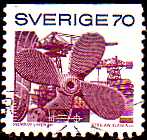
| |
From 1920 on the diesel engine became the engine of choice for tug ships. These engines do not need the
long warm-up times like steam engines, and have a higher degree of effectiveness, greater performance,
lower weight and are easier to use. The German high-sea tug "Arctic" has got two 16 cylinders four-stroke
diesel engines together with 17,500 hpi aboard. She can run up to 20.5 kn and mounts a bollard pull of 150 tons.
Two shiftable propellers and three rudders make the work easier. The so-called altering or Pitch-propeller
used rotary propeller sheets. Thus the grade and the push could be controlled more directly than by engine
power alone.
|
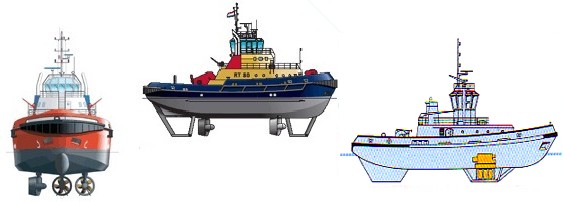
|
Modern tugs are equipped with a Schottel- or a Voith-Schneider-propulsion. As there are no stamps depicting
these drives, use the picture above as a reference. The Schottel drive (also called Z-drive) has a rotating
screw in a so-called Kort nozzle. The screw can rotate 360 degrees and can steer the tug in every direction.
In fact the tug doesn't need a rudder any more. The Dutch Kooren "Rotor Tugs" have three propellers, one below
the stern and two under the forecastle, see above. The rotor Tug 100E has the measures of 141 ft. * 52 ft. *
23 ft., a performance of 7,000 kW and a bollard pull of 115 tons.
With the Voith-Schneider type propulsion the push is arbitrarily adjustable in strength and direction
without changing speed. Equipped with 2 propellers the tug can move in every direction without rudders - even
sideways. The propeller has 6 wings which are ordered into a circular rotor.
Two propulsion units are installed under the forecastle, only a keel fin is at the stern, see above right.
Voith Schneider tugs are called tractor tugs. A typical Voith-Schneider port tractor
measures 122 ft * 43 ft * 20ft, machine performance of 5,300 kW, speed of 13.5 kn and a bollard pull
of 75 tons.
|
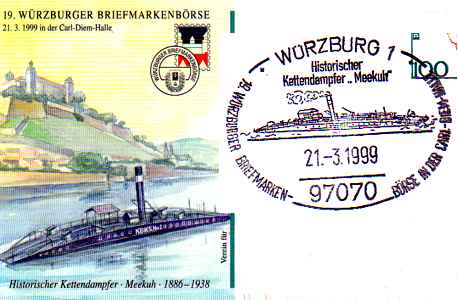
|
From 1868 to approx. 1900 chain dragging navigation was used on the river Elbe.
The chain, lying in the river, ran up to the ship where it entered two machine-driven chain drums and from there
back into the river. So the ship towed itself along the chain up the river. These ships had engines with 60 to 130 hp
and towed up to 10 lighters against the current.
Chain dragging navigation was also utilised on the river Main.
The "Meekuh" (depicted above) continued it's service up to 1938. Today it is used as a historical
museum at Würzburg.
|
Sources:
Dear/Kemp, The Oxford Companion to Ships and of The Sea
Wikipedia Internet dictionary
Various Internet pages of the companies Voith Ship Technology and Kooren Shipbuilding and Trading
|
|